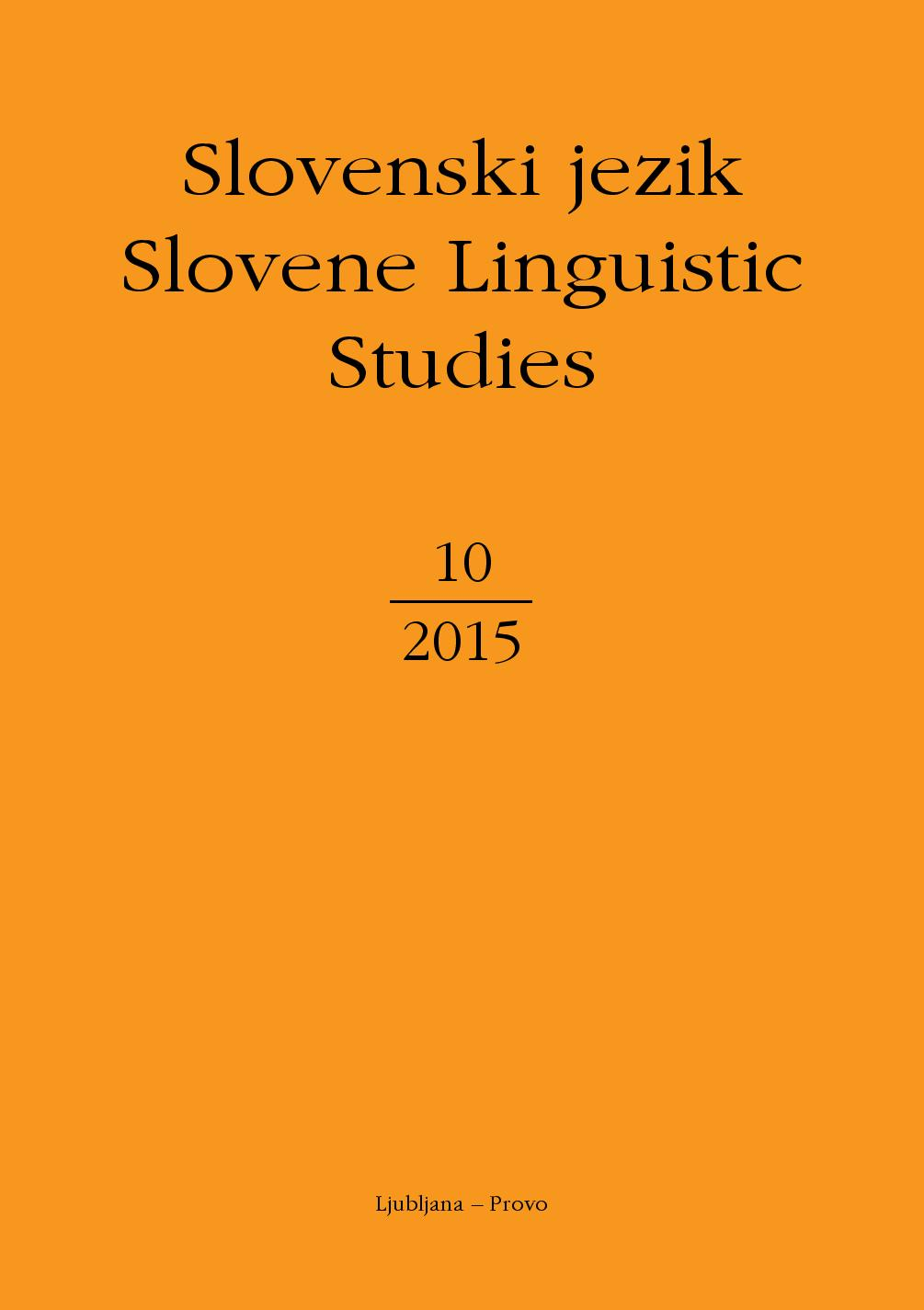Hedging strategies and linguistic devices in radio interviews
Abstract
This contribution examines hedging strategies and devices employed by journalists in selected interviews from two Slovene public radio programmes. Genre and discourse frameworks are taken into account, as they determine journalists‘ linguistic choices in general. The results are then compared to those from two Slovene language corpora, namely Gigafida (corpus of written texts) and GOS (corpus of oral communication), in order to determine how typical of radio interviews the hedging devices in question are. In the first section of the paper a brief account of the evolution of hedging as a concept and an overview of the past and recent research in the field are given as well as the arguments for the Slovene translation of the terms hedging and (to) hedge.
Downloads
References
Adams, Sally. 2005. Interviewing for Journalists. London, New York: Routledge.
Bradac, James J., Anthony Mulac in Sandra A. Thompson. 1995. Men‘s and Women‘s Use of Intensifiers and Hedges in Problem-Solving Interaction: Molar and Molecular Analyses. Research on Language and Social Interaction 28 (2): 93–116.
Crompton, Peter. 1997. Hedging in Academic Writing: Some Theoretical Problems. English for Specific Purposes 16 (4): 271–287.
Farr, Fiona in Anne O’Keeffe. 2002. Would as a hedging device in an Irish context: An intra-varietal comparison of institutionalised spoken interaction. V Randi Reppen in dr. (ur.), Using Corpora to Explore Linguistic Variation, 25–48. Amsterdam, Philadelphia: John Benjamins.
Fetzer, Anita. 2010. Hedges in Context: Form and Function of Sort of and Kind of. V Kaltenböck in dr. (ur.), New Approaches to Hedging, 49–72. Bingley: Emerald.
Fraser, Bruce. 2010a. Pragmatic Compeence: The Case of Hedging. V Kaltenböck in dr. (ur.), New Approaches to Hedging, 15–34. Bingley: Emerald.
Fraser, Bruce. 2010b. Hedging in political discourse: The Bush 2007 press conferences. V Urszula Okulska in Piotr Cap (ur.), Perspectives in Politics and Discourse, 201–214. Amsterdam; Philadelphia: John Benjamins Publishing.
Gabrovšek, Dušan in dr. 2005. Veliki angleško-slovenski slovar. Knjiga 1: A–K. Ljubljana: DZS.
Gries, Stefan Th. in Caroline V. David. 2007. This is kind of / sort of interesting: variation in hedging in English. Studies in Variation, Contacts and Change in English 2: Towards Multimedia in Corpus Studies. Dostopno prek: www.helsinki.fi/varieng/series/volumes/02/gries_david/ (12. 2. 2015).
Jalilifar, A. R. in M. Alavi. 2011. Power and Politics of Language Use: A Survey of Hedging Devices in Political Interviews. The Journal of Teaching Language Skills 3 (3): 43–66.
Kaltenböck, Gunther, Wiltrud Mihatsch in Stefan Schneider. 2010. Introduction. V Kaltenböck in dr. (ur.), New Approaches to Hedging, 1–14. Bingley: Emerald.
Kärkkäinen, Elise. 2010. Position and Scope of Epistemic Phrases in Planned and Unplaned American English. V Kaltenböck in dr. (ur.), New Approaches to Hedging, 203–236. Bingley: Emerald.
Korošec, Tomo. 1998. Stilistika slovenskega poročevalstva. Ljubljana: Kmečki glas.
Korpus Gigafida = http://www.gigafida.net
Korpus govorjene slovenščine GOS = http://www.korpus-gos.net
Košir, Manca. 1988. Nastavki za teorijo novinarskih vrst. Ljubljana: Državna založba Slovenije.
Laban, Vesna. 2007. Televizijsko novinarstvo: hibridizacija žanrov in stilov. Ljubljana: Fakulteta za družbene vede.
Lakoff, George. 1972. Hedges: A study in meaning criteria and the logic of fuzzy concepts. V Paul M. Peranteau in dr. (ur.), Papers from the 8th Regional Meeting, 183–228. Chicago: Chicago Linguistics Society.
Lakoff, Robin. 1975. Language and Women‘s Place. New York: Harper and Row.
Lengar Verovnik, Tina. 2012. Radijska dvogovornost: jezikovne izbire novinarjev. Elektronski vir. Ljubljana: Fakulteta za družbene vede, Založba FDV.
McVittie, Chris, Rahul Sambaraju in Andy McKinlay. 2011. “There Will Only Be Lots of Chit-Chat”: How Hamas Leaders and Media Interviewers Handle Controversial Topics. Research on Language & Social Interaction 44 (1): 92–105.
Pisanski Peterlin, Agnes. 2010. Hedging devices in Slovene-English translation: a corpus-based study. Nordic journal of English studies 9 (2): 171–193.
Pisanski Peterlin, Agnes. 2007. Raziskave metabesedilnosti v uporabnem jezikoslovju: pregled področja in predstavitev raziskovalnega dela za slovenščino. Jezik in slovstvo 52 (3/4): 7–19.
Poos, Deanna in Rita Simpson. 2002. Cross-disciplinary comparisons of hedging: Some findings from the Michigan Corpus of Academic Spoken English. V Randi Reppen in dr. (ur.), Using Corpora to Explore Linguistic Variation, 3–24. Amsterdam, Philadelphia: John Benjamins.
Smolej, Mojca. 2006. Vpliv besedilne vrste na uresničitev skladenjskih struktur (primer narativnih besedil v vsakdanjem spontanem govoru. Doktorska disertacija. Ljubljana: Filozofska fakulteta.
Verdonik, Darinka. 2007. Jezikovni elementi spontanosti v pogovoru. Maribor: Slavistično društvo.
Verdonik, Darinka, Andrej Žgank in Agnes Pisanski Peterlin. 2007: Diskurzni označevalci v dveh pogovornih žanrih. Jezik in slovstvo 52 (6): 19–33.
Verschueren, Jef. 2000. Razumeti pragmatiko. Ljubljana: Založba *cf.
Žele, Andreja. 2014. Slovar slovenskih členkov. Ljubljana: Založba ZRC.
Downloads
Published
How to Cite
Issue
Section
License
Authors guarantee that the work is their own original creation and does not infringe any statutory or common-law copyright or any proprietary right of any third party. In case of claims by third parties, authors commit their self to defend the interests of the publisher, and shall cover any potential costs.
More in: Submission chapter





